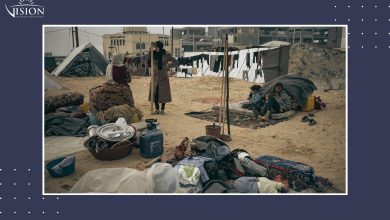Palestinian Economy Performance Report

This report presents an analysis of the economic indications to portray the performance of the Palestinian economy over recent years amid the emerging changes affecting its development, especially the tragic consequences of Covid-19, the worst dilemma affecting world economy since international financial crisis in 2008.
The report aims at providing a review of the most regional and geopolitical events impacting the Palestinian economy, as well as many other countries of the world; though, with various paces of change.
The sensitivity of the Palestinian economy situation has almost been known to everyone as being restricted and dependent on the economy of the Israeli occupation which took it as an arena for Judaization and attrition. The Palestinian economy is also featured with consumption more than production besides being heavily dependent on Arab and international external aids, making it vulnerable to crises and fluctuations.
Furthermore, the Palestinian economy struggles with restrictions imposed by Israeli occupation authorities on all economic sectors under Oslo Accords and its economic appendix, which in turn caused long-term economic imbalances that prevented the achievement of tangible economic development over the years of occupation. Thus, the issue of local economy cannot be addressed in isolation of the current political scene locally and globally.
Demographic developments
The cities of the West Bank and Gaza Strip have been witnessing a natural increase in annual population growth rate which was estimated at 2.16% in the period between 2018 and mid-2022. After that in mid 2022, it amounted to 5.36 million, including 3.19 million in the West Bank and 2.17 million in the Gaza Strip. Compared to other West Bank cities, Hebron was the most populated with 792,000 citizens. The city of Gaza came next with a population of 722,000 people. However, the city of Jericho was the least populated with only 54,000 people, while Jerusalem had a population of 477,000.
This natural increase in population growth is considered as an important demographic credit for the Palestinian cause, which struggles with policies of compulsory replacement and Judaization that have been practiced by Israeli occupation authorities for seventy-four years, with the aim of disturbing the demographic balance in favor of the occupying Jews. While thousands of Palestinians have been displaced by the Israeli occupation since the Nakba in 1948 and despite of the increasing number of martyrs on a daily basis and in light of the deterioration of the security situation in the West Bank and Gaza Strip, the occupied Palestinian territories in both areas are still, however, witnessing a remarkable annual population growth.
Figure 1. Population numbers in the West Bank and Gaza Strip in 2017-2022 (thousand people)
- Statistics available until mid-2022
Source: Palestinian Central Bureau of Statistics
Gross Domestic Product (GDP)
The Gross Domestic Product (GDP) grew in 2021 by about 7% compared to the previous year, whereas the growth rate in the same year in the West Bank and Gaza Strip was estimated at 7.84% and 3.37%, respectively.
The growth in the West Bank followed a recovery of commercial activity along with growing consumption and growing number of workers in the occupied Palestinian territories (Palestinian lands occupied in 1948) and Israeli settlements which increased from 125,000 workers in 2020 to 153,000 workers in the fourth quarter of 2021. As for the Gaza Strip, the growth pace was slower due to the Israeli attack on the Gaza Strip in May 2021 and the Israeli destruction of buildings and infrastructure. The services sector contributed to the largest share of the GDP in Palestine by about 20%, followed by the trade sector, then public administration and defense sectors.
The year of 2021 witnessed a decline in the contribution of agricultural and construction sectors, down to 6.5% and 4.7%, respectively.
Figure 2. below shows the value of the GDP for each of the West Bank and Gaza Strip, and the total of GDP for both areas in order to compare the growth and slowdown of economy from 2017 to 2021.
Figure 2. Gross Domestic Product (GDP) of each of the West Bank and Gaza Strip in 2021-2017 (million USD)
West Bank
Gaza Strip
Total
Values with fixed rates, base year 2015
Source: Palestinian Central Bureau of Statistics
Commerce
Despite the Palestinian attempts to establish economic relations with the outside world, Israeli occupation authorities controlled all Palestinian crossings and borders with neighboring countries, enabling Israel to control imports and exports outlets, including final goods and raw materials. In 2021, the trade balance deficit witnessed a clear increase due to slower growth pace of exports compared to imports, with the export rate increased by 28.73% compared to last year, while imports increased by 29.13% during the same period. The Palestinian economy is considered a restricted economy for being closely associated to the economy of the Israeli occupation, as most trade operations take place along with or through the Israeli occupation, as foreign trade data shows that more than half of the total Palestinian imports come from the Israeli occupation. The same applies to Palestinian exports, which exceeded the percentage of exports to the Israeli occupation by 80% over the last five years.
Industry
Since the establishment of the Palestinian Authority, the industrial sector has been facing continual barriers due to Israel’s diminishing of the work of Palestinian industrial facilities by controlling the internal movement and raw materials coming from abroad as well as marketing and exporting industrial products. Besides, the occupation has repeatedly sought to destroy infrastructure and industrial facilities following any political or security event, with the aim of weakening and distorting the productivity of the industrial sector and slowing down its growth pace. Taking into consideration the industrial production index in the West Bank and Gaza Strip, which monitors the changes on local production volume and is directly related to the performance of economy as it reflects the ability of national products to compete based on commercial capabilities of local economy and reflects the extent of progress and development that take place within the annual productive sector, the added value of the industrial sector declined in the first quarter of 2022 by 1.46% compared to the previous quarter, due to limitation in two sub-sectors, which are the mining and quarrying sector and the manufacturing sector.
Tourism
Since the occupation of Palestine, Israeli authorities have planned to seize all significant and strategic capabilities along with natural resources in Palestine, including archaeological sites and ancient religious monuments. The occupation also worked to obliterate the identity of many archaeological sites in order to cover up their history with the aim of overturning reality and imposing different status on the ground. Other historic sites were also damaged by destruction and transformation at the hands of Israelis. The year 2022 witnessed a tangible increase in the number of hotel guests compared to the previous two years, in light of easing closures and strict measures that were implemented to counter the spread of Covid-19. In the first half of 2022, the number of hotel guests increased twice as much as it was during the same period of the previous year. As for the number of employees working in tourism sector, the figures showed that there were 54.2 thousand people working in tourism during the second quarter of 2022, with a 28% of increase in the number of workers compared to the second quarter of 2021.
Agriculture
The agricultural sector in Palestine is an important pillar and one of the main components of its economy. It contributes a significant percentage of the annual economic value, added to its importance in achieving self-sufficiency, food security and job opportunities for the workforce in society. The number of workers in this sector approached 44 thousand in 2021, with cultivated land area representing about 19% of the total land area in the territories of the Palestinian Authority.
Figure 3. shows the percentage of cultivated and uncultivated lands in the Palestinian Authority territories, according to the latest agricultural survey in 2021. The cultivated land area in the Palestinian Authority regions was about 1,138,522 dunums, of which 1,048,833 dunums were in the West Bank and 89,689 dunums in the Gaza Strip. The cultivated area represents about 19% of the total land area in the territories of the Palestinian Authority, and the cultivated land area in the West Bank and Gaza Strip amounted to 19% and 25%, respectively.
Figure 3. Total area and cultivated land area in the West Bank and Gaza Strip in 2021 (in dunums)
West Bank
Palestinian Authority lands
Gaza Strip
Cultivated area.
Uncultivated area.
Source: Palestinian Central Bureau of Statistics
Constructions
The construction sector is a pioneering and majorly influential sector in the Palestinian economy depending on its contribution to gross domestic product (GDP), investment, employment, and the average wages of its workers. It cannot be denied that the construction sector, like other sectors, suffers from problems that inhibit its work and production, such as the Israeli policy of land confiscation and settlement expansion that limit the chances of finding available lands, and the Israeli control over large land areas leading to difficulties in obtaining construction permits. This is added to the Israeli occupation’s control over crossings and borders that lowers the possibility of obtaining necessary building materials and leads to fierce competition in attracting Palestinian labor in light of high wages of workers of the same sector in the Israeli market. In 2022, the percentage of workers in the construction sector in the Palestinian Authority territories ran to 19.3% of the total workforce, with an average daily wage of 143.7 shekels in the West Bank and 39.5 shekels in the Gaza Strip.
Inflation
It can be said that the rate of inflation in Palestine, compared to neighboring countries and the countries of the Middle East, is almost moderate to low. However, the specificity of the Palestinian case makes the effect of inflation different from the calculations of the rest of countries.
The dependence of local economy on the economy of the Israeli occupation and the large dependence of local consumption on exports from the outside has led to the inflation rate being affected by external factors more than internal ones. This price hike causes an increase in the cost of living for citizens, and accordingly leads to food insecurity followed by the expansion of poverty, as 31.5% of Palestinian families suffer from food insecurity, according to the Arab Monetary Fund’s report. The latest Palestinian census survey on the economic and social conditions of Palestinians showed that 29.9% of the Palestinian families living in the Palestinian Authority territories are classified as poor with a percentage of 13.6% of the poor families in the West Bank and 54.2% in the Gaza Strip.
Labor market
The number of Palestinian workers in the third quarter of 2022 approached about 1.151 million, with an increase of 3.3% compared to the previous quarter. The same quarter witnessed a decrease in the number of workers in the Palestinian territories occupied in 1948 by about 11 thousand workers compared to the previous quarter, while the number of Palestinian workers in settlements declined by about two thousand workers. This decrease in the number of workers followed tightening of security measures over concerns of security tension in contact areas, which have recently witnessed an escalated resistance incidents against the Israeli occupation. While the total number of Palestinian workers in the occupied territories witnessed an unprecedented increase during the past few years as a result of high wage average compared to the local wage average, the daily wage average for workers in the territories occupied in 1948 and in Israeli settlements reached 283.5 shekels, while the average daily wage for workers in the West Bank and Gaza Strip, ran to 129 shekels and 53.5 shekels, respectively. As for local market, the number of workers increased during the third quarter of 2022 up to 953 thousand. This increase followed recovery in the local economy as various economic sectors began to return to their previous activity before Covid-19 pandemic. Despite such an improvement and recovery, unemployment rates in the Palestinian Authority territories are yet considered high. Statistical surveys of Palestinian employment showed that the unemployment rate runs to 24.2%; the highest rate of which was in the Gaza Strip, which amounted to 44.1%, followed by the West Bank, with a percentage of 13.8%.
Figure 4. Unemployment rate in the Palestinian Authority territories by gender and region in the second quarter of 2022 (%).
Palestinian Authority Territories: 24.2%
West Bank: 13.8%. Female: 22.0%. Male: 11.8%
Gaza Strip: 44.1%. Female: 65.1%. Male: 38.2%
Source: Palestinian Central Bureau of Statistics





